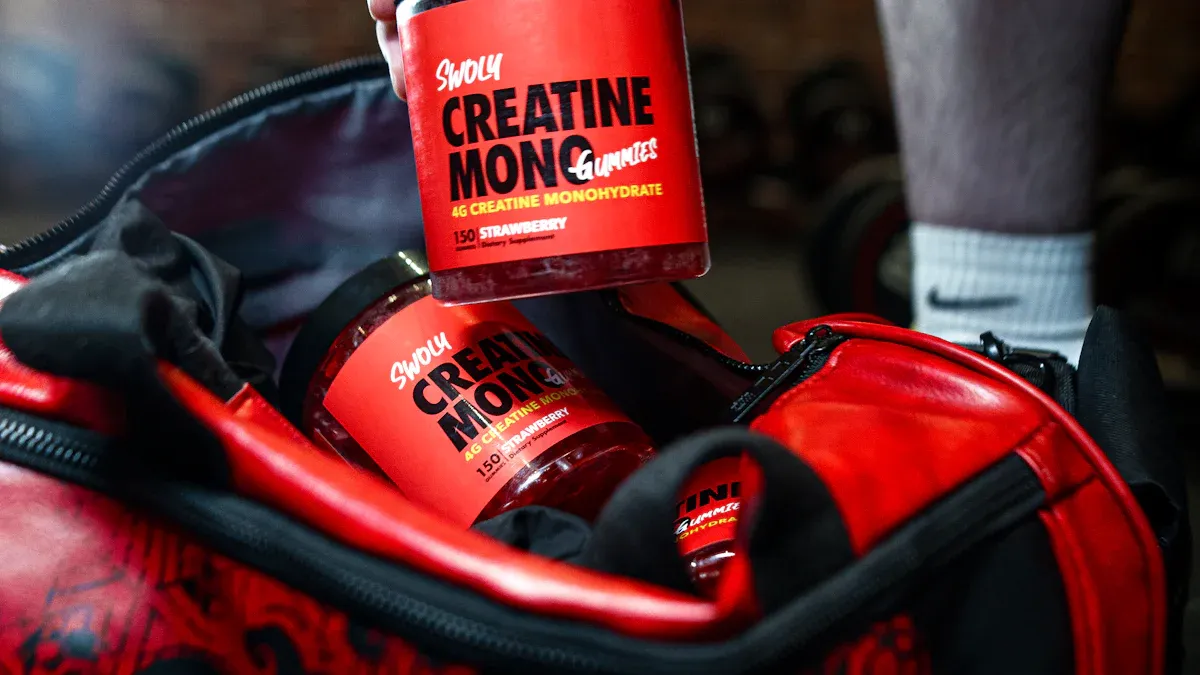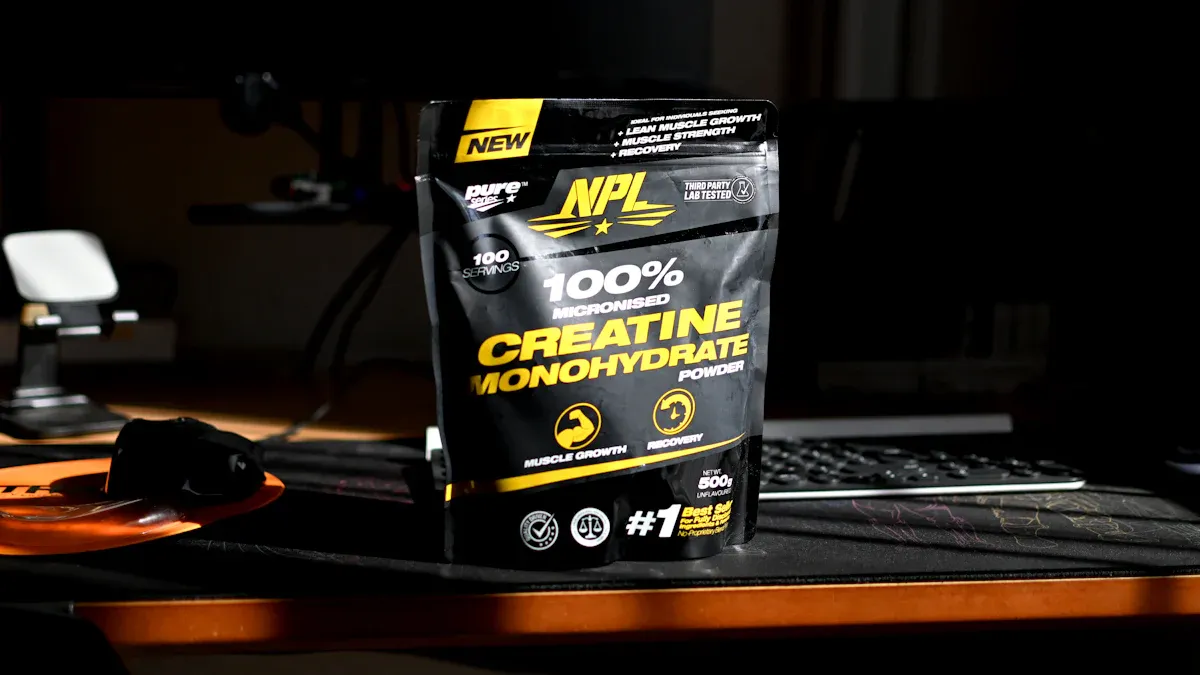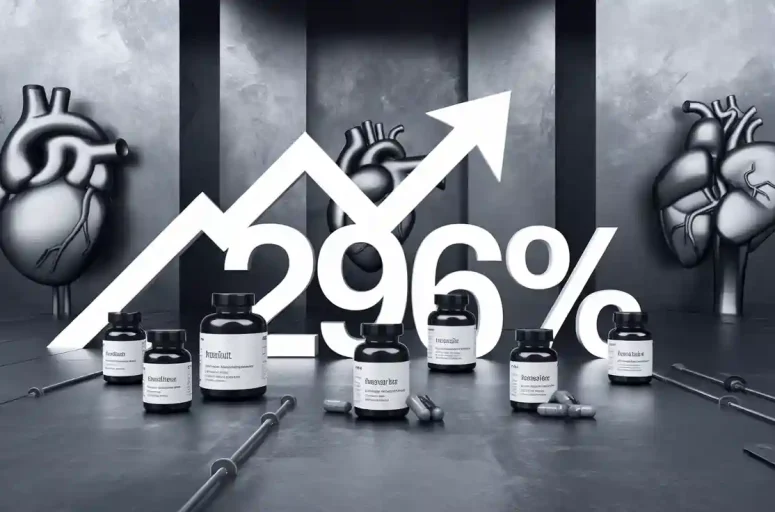
If you’re thinking about when to take creatine, timing matters. The best time is right before or after exercise. This helps your muscles heal faster and grow stronger. On rest days, take creatine at the same time daily. It’s better to take it with food to keep levels steady. Studies show timing doesn’t change results much, but being consistent is important. Use creatine daily like a regular supplement for long-term benefits.
Key Takeaways
Use creatine before or after workouts to help muscles grow.
Take creatine every day, even on rest days, to keep it working.
Eat creatine with carbs and protein to help your body absorb it.
Drink plenty of water with creatine to keep muscles healthy.
Change your creatine amount based on your weight and activity.
Mix creatine with cool or room-temperature drinks to keep it strong.
Write down your progress to see how creatine helps your muscles.
Creatine is safe if used long-term; follow the right dose to avoid problems.
What is creatine and how does it work?

The role of creatine in muscle growth
Creatine helps muscles grow bigger and stronger. It pulls water into muscle cells, making them swell. This swelling tells muscles to start growing. Even beginners see muscle size and strength improve with creatine.
Here’s why creatine works so well:
It helps muscles heal quickly after workouts.
It improves the inside of muscle cells for better growth.
It benefits both new and experienced athletes.
Taking creatine after exercise is great. Muscles absorb nutrients best right after a workout.
How creatine supports energy production
Creatine acts like a charger for your muscles. During hard exercise, muscles use ATP (adenosine triphosphate) for energy. But ATP runs out fast. Creatine helps make more ATP by boosting phosphocreatine in muscles.
This lets you work harder during short, intense activities like sprinting or lifting weights. Studies show creatine keeps your strength and power high during these efforts.
Key Findings | Description |
|---|---|
Phosphocreatine Role | Phosphocreatine helps muscles make more ATP during tough exercise. |
Creatine Supplementation | Taking 20-25 g/day for 5-7 days raises muscle creatine levels. |
Performance Improvement | Creatine keeps strength and power up during short, intense workouts. |
Mechanism of Action | Faster phosphocreatine recovery boosts performance in repeated exercises. |
Creatine helps you train harder and recover faster. Over time, this leads to better results.
Why creatine is essential for athletes and bodybuilders
If you want stronger muscles or better performance, creatine is key. It’s one of the most studied supplements and works for many people.
Here’s why creatine is important:
It builds strength and size for people of all fitness levels.
Athletes in sports like soccer or basketball get extra energy from creatine.
Dr. Kaufman, an expert, says creatine always delivers muscle-building results. Whether lifting weights or playing sports, creatine helps you perform your best.
Does timing matter for creatine supplementation?
Best time to take creatine on workout days
Timing your creatine on workout days can affect your results. While being consistent is key, taking it before or after exercise has benefits.
Benefits of taking creatine before workouts
Taking creatine before exercise gives your muscles extra energy. It boosts phosphocreatine, which helps make ATP, your body’s quick energy source. This lets you work harder during short, intense activities like lifting weights or sprinting.
When your muscles have more energy, you can do more reps or lift heavier. Over time, these small improvements lead to better strength and endurance gains.
Taking creatine before workouts also prepares your muscles to perform their best. This is especially helpful for high-intensity or explosive exercises.
Benefits of taking creatine after workouts
Taking creatine after exercise helps with recovery and muscle growth. After a workout, your muscles absorb nutrients better, making it a great time to replenish creatine.
Research shows post-workout creatine can improve body composition and strength. One study found people who took creatine after workouts gained more muscle and lost more fat than those who took it before.
Both pre- and post-workout creatine have advantages. Choose what fits your routine best. The most important thing is to take it daily and stay consistent.
Study | Timing of Creatine Supplementation | Findings |
|---|---|---|
Antonio and Ciccone (2013) | Pre vs. Post | Similar increases in muscle thickness and strength after 4 weeks of training. |
Candow et al. (2014b) | Pre vs. Post | No significant differences in muscle mass and strength after 12 weeks of training. |
Candow et al. (2015) | Pre vs. Post | Post-exercise group showed greater lean mass increase compared to placebo, but no significant difference between pre and post groups. |
When to take creatine on rest days
Rest days are just as important for creatine as workout days. Even without exercise, your muscles need creatine to stay ready for your next session.
Importance of consistency on rest days
The best time to take creatine on rest days is whenever it works for you. The key is to take it daily. This keeps your muscle creatine levels high and ready for action.
Experts say there’s no perfect time for creatine on rest days. Just stick to a routine, whether it’s morning, afternoon, or evening.
Taking creatine with food for better absorption
Pairing creatine with food on rest days helps your body absorb it better. Foods with carbs and protein improve creatine uptake. For example, mix it into a smoothie or take it with breakfast.
This method also makes it easier to remember your dose. Plus, taking creatine with food can reduce stomach discomfort.
In summary, rest days are about consistency and absorption. Take creatine at the same time daily and pair it with food for the best results.
How to take creatine for best results
Should you take creatine with food?
Taking creatine with food helps your body absorb it better. Pairing it with carbs and protein makes muscles soak it up faster. Let’s explain why.
How carbs help creatine absorption
Carbs are important for creatine absorption. Eating carbs makes your body release insulin, which moves creatine into muscles. Studies show creatine works better with a high-carb meal or drink. For example, Green et al. (1996a) found creatine with 95 grams of glucose improved muscle storage.
Here’s an idea: Mix creatine with fruit juice or a smoothie. This simple trick boosts absorption and gives better results.
Why protein helps with muscle recovery
Protein helps muscles heal and improves creatine absorption when paired with carbs. Steenge et al. (2000) found creatine with carbs and protein stays in muscles longer.
Try adding creatine to a post-workout shake with protein powder and a banana. This helps muscles recover and loads them with creatine for your next workout.
Can creatine be used with other supplements?
You might wonder if creatine works with other supplements. The answer is yes, but there are some things to know. Let’s look at how creatine interacts with common supplements.
Creatine and pre-workout drinks
Pre-workout drinks often have caffeine, beta-alanine, or nitric oxide boosters. These boost energy, but caffeine might reduce some creatine benefits. Research shows caffeine could affect muscle relaxation time. However, occasional caffeine use may not harm creatine’s long-term effects.
If you use pre-workout drinks, check for caffeine. You can still take creatine but try spacing it out from your pre-workout drink.
Creatine and post-workout shakes
Post-workout shakes are great with creatine. They usually have carbs and protein, which improve creatine absorption. Taking creatine after exercise also helps muscles absorb nutrients better.
For quick recovery, mix creatine into your post-workout shake. This helps muscles heal and grow stronger.
Tips for mixing and drinking creatine
How you mix and drink creatine matters. Follow these tips to make it work better.
Water vs. other drinks
Water is easy for mixing creatine and keeps you hydrated. But liquids like fruit juice or milk can boost absorption by raising insulin levels.
Here’s a guide:
Use water for simplicity and hydration.
Choose juice or milk for better absorption and taste.
Avoiding mistakes (e.g., hot liquids, bad mixing)
Don’t mix creatine with hot liquids. Heat can ruin creatine’s effectiveness. Use cold or room-temperature drinks. Stir or shake well to avoid clumps.
Don’t let creatine sit too long in liquid. It can turn into creatinine, which doesn’t work as well. Drink it right after mixing for full benefits.
Follow these tips to get the most from your creatine. Ready to start? Check out this top-rated creatine supplement to boost your strength and energy.
How much creatine should you take?
Knowing the right amount of creatine to take is important. The correct dose helps you get benefits without overdoing it. Let’s explain it step by step.
Standard dosage for creatine monohydrate
What is the loading phase?
The loading phase is a way to start creatine use. You take a higher dose to quickly fill your muscles with creatine. Usually, this means taking 20-25 grams daily for 5-7 days. Split it into smaller doses to avoid stomach problems.
Another way is to base your dose on body weight. For example, take 0.3 grams per kilogram of body weight daily for at least three days. This method works well if you want a more tailored approach.
Dosage Type | Amount | Duration |
|---|---|---|
Loading Dose | 20-25 grams per day | 5-7 days |
Weight-Based Dose | 0.3 g per kg per day | At least 3 days |
What is the maintenance phase?
After loading, you move to the maintenance phase. This means taking a smaller daily dose to keep creatine levels high. Most people take 3-5 grams daily during this phase. If you prefer, you can also take 0.03 grams per kilogram of body weight daily. This keeps your muscles full without wasting creatine.
Dosage Type | Amount | Duration |
|---|---|---|
Maintenance Dose | 3-5 grams per day | Ongoing |
Weight-Based Dose | 0.03 g per kg per day | Ongoing |
Adjusting dosage for size and activity
Your creatine needs depend on your size and activity level. Higher doses, like 0.3 grams per kilogram daily, can boost strength faster. Moderate doses, like 0.1 grams per kilogram daily, also work but take longer. If you’re very active or larger, slightly higher doses may help.
A study compared three groups: high (0.3 g/kg/day), moderate (0.1 g/kg/day), and placebo (0.4 g/kg/day of maltodextrin).
All groups improved strength, but higher doses worked faster.
Adjusting your dose based on size and activity can improve results.
Can you take too much creatine?
Creatine is safe, but too much can cause problems. High doses might lead to stomach pain, bloating, or diarrhea. Long-term overuse could harm kidneys or liver, though studies haven’t proven this in healthy people.
Study | Findings |
|---|---|
Population Study | No major liver issues with low (<1 g/day) or high (>2 g/day) doses. |
Souza et al. (2009) | Rodents had liver damage with very high creatine intake. |
Marinello et al. (2019) | Creatine with alcohol caused liver stress and damage. |
Case Reports | High doses linked to liver injury in young men using creatine. |
Stick to the recommended doses to stay safe. If unsure, ask a doctor before starting creatine supplements.
Extra tips to get the most from creatine
Drink enough water when using creatine
Drinking water is very important with creatine. Creatine pulls water into your muscles, helping them work better. But this means you need to stay hydrated to avoid problems.
Here’s how to stay hydrated:
Keep a water bottle with you and drink often.
Look at your urine color. Light yellow means you’re hydrated. Dark yellow means drink more water.
Eat foods with water like watermelon, cucumbers, and oranges.
Drink more water if you’re very active or sweating a lot.
Studies show creatine doesn’t make dehydration or heat problems worse. It might even help control your body temperature and heart rate during hard workouts. Staying hydrated helps creatine work better and keeps you healthy.
Pair creatine with good food and exercise
Creatine works best with a healthy diet and exercise plan. It gives you energy for tough workouts, letting you train harder and recover faster. To get the most out of it, eat the right foods.
Here’s what to do:
Eat meals with protein, carbs, and healthy fats. Protein fixes muscles, and carbs give energy for workouts.
Use creatine with strength training. Research shows this can grow muscles and make you stronger in just two weeks.
Be consistent. Taking creatine regularly and eating well gives better results over time.
Creatine can boost workout performance by up to 15%. It also helps muscles grow, making it a great fitness tool. Want a good creatine product? Check out this top-rated creatine supplement.
Track your progress and adjust as needed
Keeping track of your progress shows how creatine is helping you. It also helps you change your routine to meet your goals. Start by writing down what you eat and how much creatine you take. This helps you see what’s working.
Here’s how to track and adjust:
Start with a loading phase: Take 20 grams daily for 5-7 days to fill your muscles. Then switch to 3-5 grams daily.
Write down your workouts and energy levels. Creatine gives energy for things like lifting weights or sprinting. Look for improvements.
Check your strength and muscle growth every few weeks. If you’re not improving, check your diet and workouts to make sure they match your goals.
Tracking helps you see if your creatine plan is working or needs changes. This step-by-step method keeps you focused and helps you reach your fitness goals.
Taking creatine at the right time and regularly is important. Use it before or after workouts to help muscles recover and grow. On days you don’t exercise, take it at the same time daily with food for better absorption.
Being regular with creatine matters more than timing. Combine it with healthy meals, enough water, and good workouts to get the best results. Follow the suggested amount to avoid problems and keep it working well over time.
Here’s a simple guide for using creatine effectively:
Evidence Type | Details |
|---|---|
Dosage | |
Timing | Effects start 3.5 hours after use and last up to 9 hours |
Benefits | Helps with mental tasks, especially when tired |
Stick to these tips to improve your workouts and performance. Creatine works great when used properly, so stay regular and check your progress to keep getting better.
FAQ
Can you take creatine every day?
Yes, take creatine daily for the best results. On workout days, use it before or after exercise. On rest days, take it at the same time each day. Being consistent keeps your muscle creatine levels steady.
Does creatine cause weight gain?
Creatine can make muscles hold more water, making them look bigger. This isn’t fat—it’s just water in your muscles. Over time, creatine helps grow muscle, which adds healthy weight.
Is creatine safe for teenagers?
Creatine is usually safe for teens who work out often. Stick to the recommended dose of 3-5 grams daily. If unsure, ask a doctor or coach before starting.
Can you mix creatine with coffee?
You can mix creatine with coffee, but caffeine might lower some benefits. If you drink coffee, take creatine at a different time. This avoids any possible issues with muscle relaxation.
How long does creatine take to work?
Creatine works in about a week if you use a loading phase. Without loading, it may take 2-4 weeks to see results. Benefits include more energy, strength, and faster muscle recovery.
Should you cycle off creatine?
You don’t have to stop using creatine. Studies show it’s safe for long-term use. If you want to cycle, take creatine for 8 weeks, then stop for 4 weeks. Some people prefer this method.
Can creatine cause dehydration?
No, creatine doesn’t make you dehydrated. It moves water into your muscles, so drinking enough water is important. Stay hydrated to avoid problems.
What’s the best type of creatine?
Creatine monohydrate is the best and most studied type. It’s cheap and works well for building muscle and improving performance. Other types exist, but monohydrate is the top choice.



1 comment